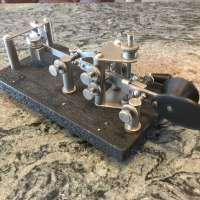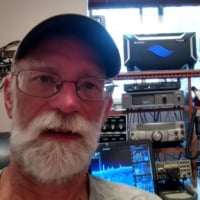SmartSDR v4.1.3 | SmartSDR v4.1.3 Release Notes
SmartSDR v3.10.15 | SmartSDR v3.10.15 Release Notes
The latest 4O3A Genius Product Software and Firmware
Need technical support from FlexRadio? It's as simple as Creating a HelpDesk ticket.
Audio Effect For CW Pileups

The new Elecraft K4 has an audio effect feature called pitch mapping. It places lower pitched CW tones in the left ear and higher pitched CW tones in the right ear. The idea is to help separate close spaced CW signals. This got me thinking about replicating or simulating something like this on my Flex 6600M.
Using two slices with volume panned in each respective ear I was able to create a pretty cool effect which allowed me to listen to two close spaced CW signals with one in each ear. This dramatically increased my ability to copy each signal individually. Perhaps good in a pileup situation ?
This would only be good for running in a contest as there is no way to lock the slices together while tuning the band.
I also experimented with a third slice placed in between with balance control in the center which also seemed effective but was difficult to access and adjust the slices. I would transmit on the center slice allowing 400 HZ either side of my transmitted signal. Probably better setup for a run frequency situation in a contest ?
I will play around with this more in the next CWT and see what it sounds like.
Has anyone ever tried anything like this before ?
Comments
-
Joe,
As I recall, you can lock slices using FRStack. SmartSDR for Mac allows you to sync two slices with an associated offset frequency. For my operating style this doesn't do much for me other than create interesting audio affects. Haven't figured out anything of great utility .. but I just might stumble onto something!
On AM, you could listen to both sidebands separately but SAM does much the same.
Daniel - W7NGA, Seaside Oregon
0 -
Thanks for the info Daniel. I now have the slices tracking each other via FRStack.
0 -
PY5ASN back in early 1971 my novice era had a wonderful combination of Hum, BUZZ, Chirp and drift... I followed him with the receiver right out of the novice band one day... Now try to think what 10,000 guys in a pileup with audio effects on their cw signals is going to sound like? I just don't know what to think about that Joe.
I guess Time will tell,
Erika DD
0 -
Great idea!
0 -
A few years back, I experimented with using 2 slices, slightly offset, so that my intended station produced a harmonically pleasant tone, and stations further away produced tonally dis-chordant tones. (It helps to be a musician)
At times, it added some additional copy clarity to the weak DX station, and enabled me to reject the other traffic.
0 -
Hi Ken, I tried a similar thing where I put the desired station on CWU on one slice and one on LSB on the other slice offset by my tone freq. I then dragged the LSB filter skirts to match the CW skirts. It helps to get a signal truly at zero beat, but a just a few Hz off and it sounds horrible. It did not do much for rejecting stations farther away, so all-in-all, while an interesting experiment, it was not a good way to operate. I was hoping the station on freq would stand out from the crowd, but not so much...
With todays brick wall DSP filters, this is all a bit of a moot point. I can narrow down the filters so far without ringing that I almost never hear other stations in the passband.
How the heck did I ever make contacts with my HR-10B???
0 -
>How the heck did I ever make contacts with my HR-10B???
You probably had the mighty DX60B matching transmitter!
1 -
I would have loved a DX-60B! My first transmitter was a one tube 5 watter made entirely from scavenged TV parts. I quickly moved to a 1625 job from the handbook that was supposed to load up to 75 W input, but it only managed about 35 W.
It is fun to think about the old days, but I think I will stick with my Flex!
0 -
Identical story. Scavenged TV’s, 6AG7 oscillator, saved my money and added an 807 final, BC-348 receiver out of a B-17 bomber. Most fun I’ve ever had in amateur radio.
My 6600 is greatly appreciated however!
0 -
I played around with this some more during the CWT today. I was able to get good left and right separation and good sound quality with the following settings.
Set each slice to the same frequency with 250 HZ CW filter.
Adjust the filter passbands so they do not overlap each other. About 200 HZ or so each side of center. Total of about 400 HZ.
Adjust volume sliders. Slice A full left and Slice B full right.
Tune in a station calling CQ while listening and watching stations responding on the panadapter. Callers who would answer at a lower (RF) frequency would be in my left ear and callers who answered at a higher (RF) frequency would be in my right ear. Callers who answered on frequency would be in the middle. Pretty cool !
Here you can see a station calling CQ with a couple of stations responding lower in frequency which were in my left ear. The station calling CQ was in both ears centered.
1 -
Very cool Joe! I will give it a try.
EDIT: It works! That is really cool. I just spread out the filters to 1KHz on each side just to play, and it really works. It is kind of cool to hear close-in signals in different ears, and only the center tuned signal right in the center.
I haven't decided if this is a novelty or a useful feature. I will have to experiment when the band is really crowded.
Thanks for posting this here.
0 -
That’s great Len! Yes, more experimentation is required. It’s amazing how the brain can decode multiple signals if they are separated enough.
Notes:
Setting the filter passbands correctly requires some patience. First separate the slices and adjust the filters and then move the slices together on the same frequency.
You can save as a global profile once you get everything setup the way you like it.
You will need FRStack for slice tracking if you want to tune around the band.
0 -
I find that the tracking function in FRS loses lock by 10 Hz when I first start tuning. Then it keeps up. That 10 Hz beat note modulating the signal is not too pleasant to listen to...
In my case, I have a VFO tracking feature in my TeensyMaestro as well as the ability to set width and offset using knobs. So I hit the A>B menu function to copy A to B, then set both VFOs to the same bandwidth and offset one to the left and one to the right. Now when I turn either VFO knob, everything stays in sync. I can put each VFO step to a different value so that one knob tunes fast and the other slow.
Fun stuff...
1 -
After more listening and tweaking I have found this setting offers some noise reduction benefits compared to just listening to a single slice with audio centered and filter passband centered. I was also able to create this noise reduction effect by using a single slice with audio centered and filter passband moved to the left of center. There was a very noticeable drop in band noise. Static crashes seemed to be suppressed as well. I was able to copy weak stations more easily. Perhaps this is "psychoacoustics" at play ?
0
Leave a Comment
Categories
- All Categories
- 381 Community Topics
- 2.1K New Ideas
- 633 The Flea Market
- 8.3K Software
- 131 SmartSDR+
- 6.4K SmartSDR for Windows
- 185 SmartSDR for Maestro and M models
- 430 SmartSDR for Mac
- 272 SmartSDR for iOS
- 259 SmartSDR CAT
- 197 DAX
- 382 SmartSDR API
- 9.4K Radios and Accessories
- 42 Aurora
- 265 FLEX-8000 Signature Series
- 7.2K FLEX-6000 Signature Series
- 955 Maestro
- 56 FlexControl
- 866 FLEX Series (Legacy) Radios
- 929 Genius Products
- 464 Power Genius XL Amplifier
- 340 Tuner Genius XL
- 125 Antenna Genius
- 297 Shack Infrastructure
- 209 Networking
- 461 Remote Operation (SmartLink)
- 144 Contesting
- 788 Peripherals & Station Integration
- 140 Amateur Radio Interests
- 1K Third-Party Software






